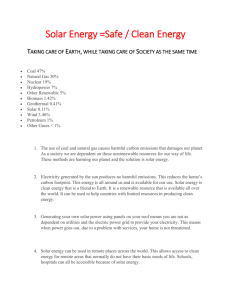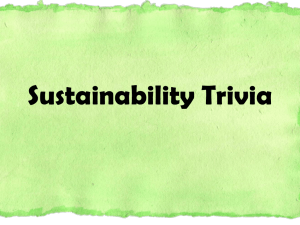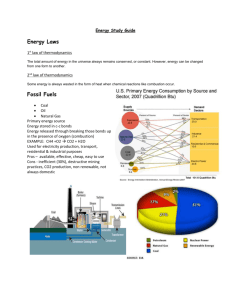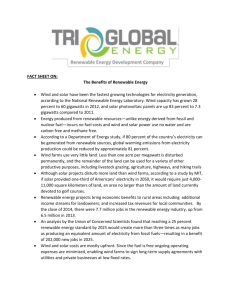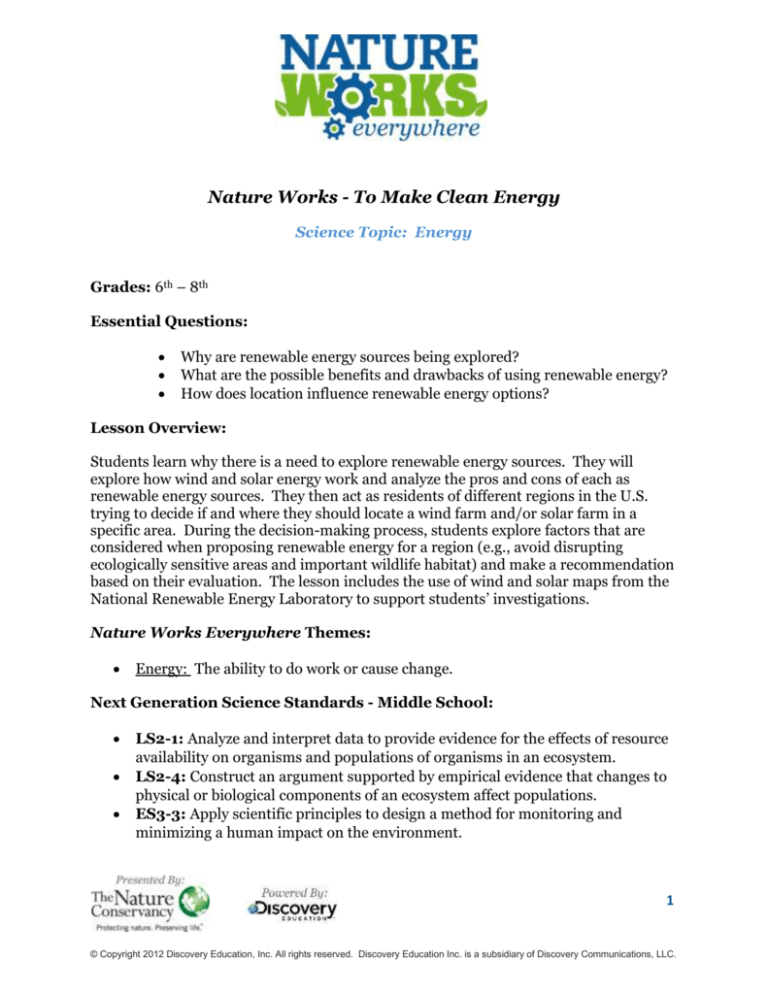
Nature Works - To Make Clean Energy
Science Topic: Energy
Grades: 6th – 8th
Essential Questions:
Why are renewable energy sources being explored?
What are the possible benefits and drawbacks of using renewable energy?
How does location influence renewable energy options?
Lesson Overview:
Students learn why there is a need to explore renewable energy sources. They will
explore how wind and solar energy work and analyze the pros and cons of each as
renewable energy sources. They then act as residents of different regions in the U.S.
trying to decide if and where they should locate a wind farm and/or solar farm in a
specific area. During the decision-making process, students explore factors that are
considered when proposing renewable energy for a region (e.g., avoid disrupting
ecologically sensitive areas and important wildlife habitat) and make a recommendation
based on their evaluation. The lesson includes the use of wind and solar maps from the
National Renewable Energy Laboratory to support students’ investigations.
Nature Works Everywhere Themes:
Energy: The ability to do work or cause change.
Next Generation Science Standards - Middle School:
LS2-1: Analyze and interpret data to provide evidence for the effects of resource
availability on organisms and populations of organisms in an ecosystem.
LS2-4: Construct an argument supported by empirical evidence that changes to
physical or biological components of an ecosystem affect populations.
ES3-3: Apply scientific principles to design a method for monitoring and
minimizing a human impact on the environment.
1
© Copyright 2012 Discovery Education, Inc. All rights reserved. Discovery Education Inc. is a subsidiary of Discovery Communications, LLC.
ES3-4: Construct an argument supported by evidence for how increases in
human population and per-capita consumption of natural resources impact
Earth’s systems.
ETS1-1: Define the criteria and constraints of a design problem with sufficient
precision to ensure a successful solution, taking into account relevant scientific
principles and potential impacts on people and the natural environment that may
limit possible solutions.
ETS1-2: Evaluate competing design solutions using a systematic process to
determine how well they meet the criteria and constraints of the problem.
Next Generation Science Standards - High School:
HS-PS3-2. Develop and use models to illustrate that energy at the macroscopic
scale can be accounted for as a combination of energy associated with the
motions of particles (objects) and energy associated with the relative position of
particles (objects).
HS-PS3-3. Design, build, and refine a device that works within given constraints
to convert one form of energy into another form of energy.
HS-PS4-5. Communicate technical information about how some technological
devices use the principles of wave behavior and wave interactions with matter to
transmit and capture information and energy.
HS-LS2-6. Evaluate the claims, evidence, and reasoning that the complex
interactions in ecosystems maintain relatively consistent numbers and types of
organisms in stable conditions, but changing conditions may result in a new
ecosystem.
HS-LS2-7. Design, evaluate, and refine a solution for reducing the impacts of
human activities on the environment and biodiversity.*
HS-LS4-2. Construct an explanation based on evidence that the process of
evolution primarily results from four factors: (1) the potential for a species to
increase in number, (2) the heritable genetic variation of individuals in a species
due to mutation and sexual reproduction, (3) competition for limited resources,
and (4) the proliferation of those organisms that are better able to survive and
reproduce in the environment.
HS-LS4-6. Create or revise a simulation to test a solution to mitigate adverse
impacts of human activity on biodiversity.*
2
© Copyright 2012 Discovery Education, Inc. All rights reserved. Discovery Education Inc. is a subsidiary of Discovery Communications, LLC.
HS-ESS3-1. Construct an explanation based on evidence for how the availability
of natural resources, occurrence of natural hazards, and changes in climate have
influenced human activity.
HS-ESS3-4. Evaluate or refine a technological solution that reduces impacts of
human activities on natural systems.*
HS-ETS1-1. Analyze a major global challenge to specify qualitative and
quantitative criteria and constraints for solutions that account for societal needs
and wants.
HS-ETS1-2. Design a solution to a complex real-world problem by breaking it
down into smaller, more manageable problems that can be solved through
engineering.
HS-ETS1-3. Evaluate a solution to a complex real-world problem based on
prioritized criteria and trade-offs that account for a range of constraints,
including cost, safety, reliability, and aesthetics, as well as possible social,
cultural, and environmental impacts.
Time Frame:
This lesson is designed to be completed in three 45-minute sessions.
Vocabulary:
Renewable energy: Energy generated from natural resources. These sources are
considered renewable because they quickly replenish themselves and are usually
available in a never-ending supply
Nonrenewable energy: Energy generated from natural resources. These sources
are considered nonrenewable because they cannot be replenished (made again)
in a short period of time
Solar power: The conversion of sunlight into electricity.
Wind power: The conversion of wind energy into electrical power.
Whirring: Makes a low, continuous, regular sound.
Nature Works Everywhere videos that support this lesson plan:
Nature Works - To Make Clean Energy Introductory video
Scientist interview questions: See links below
Meet the Scientist: Sophie Parker
3
© Copyright 2012 Discovery Education, Inc. All rights reserved. Discovery Education Inc. is a subsidiary of Discovery Communications, LLC.
Background for the Teacher:
Solar power is energy from the sun and is considered a major source of energy because it
is freely available and can be harnessed by modern technology. Solar cells are devices
that convert light energy directly into electrical energy. Solar cells are also called
photovoltaic cells. You may have seen smaller versions of these to power calculators or
larger cells to power street signs.
Wind is caused by convection currents in Earth's atmosphere. These currents are driven
by heat energy from the Sun. Wind has huge amounts of kinetic energy that can be
transferred into electrical energy using wind turbines. The wind turns the blades, which
spin a shaft, which connects to a generator and makes electricity.
Solar and wind power are considered renewable energy sources. They both can quickly
replenish themselves and are usually available in a never-ending supply. Currently, the
main energy source used by humans is nonrenewable and cannot be replenished in a
short period of time, such as fossil fuels, coal and natural gas.
Land requirements for different energy sources vary. Several factors need to be
considered when recommending a renewable energy facility for a region. Wildlife and
habitat conservation, transmission line length and placement, land use and access to the
site for maintenance in addition to available natural resources.
Classroom Activities:
Materials
For each group of students/individual student:
Notebook paper/journal
Engage
1. Ask students, “What are ways that you use the energy of the sun and wind?”
Some anticipated responses may include flying kites, drying clothes, sailing a
boat, and growing food. Share the Nature Works – To Make Clean Energy
introductory video.
2. Provide students with images of the following: coal, oil, natural gas, wind, sun,
and water. Ask students to sort them into two categories and write down the
criteria of how they made their two categories. You can also share the images on
slide 5 and give students the same directions.
3. Provide students with the definition for renewable energy.
4
© Copyright 2012 Discovery Education, Inc. All rights reserved. Discovery Education Inc. is a subsidiary of Discovery Communications, LLC.
4. Explain to students that sunlight, water and wind are always around us. These
energy sources will not run out. Every morning, the sun rises, water moves and
the wind blows. It may be a sunny day where you live, but it may be cloudy and
windy in another location. Use the Frayer Model with students to map out the
definition of renewable energy as this term will be used frequently throughout the
lesson.
5. Provide students with the definition for nonrenewable energy.
6. You may want to use the Frayer Model again with students to map out the
definition of nonrenewable energy. Explain to students that coal, oil and natural
gas took millions of years to form and have a finite amount on Earth. These
energy sources will run out.
7. Ask students to revisit their two categories and compare how they sorted the
energy sources with their new definitions of nonrenewable energy and renewable
energy.
8. Share the Meet the Scientist: Sophie Parker video followed by the scientist video
answering the question, “Why are renewable resources being explored?” After
the video, students will explore the pros and cons of solar power and wind power
by comparing and contrasting them using resources from the US Department of
Energy (#9 and #10). Students will organize their learning with the following
graphic organizer.
5
© Copyright 2012 Discovery Education, Inc. All rights reserved. Discovery Education Inc. is a subsidiary of Discovery Communications, LLC.
9. Show the video explaining how solar energy power works:
http://energy.gov/energysaver/articles/small-solar-electric-systems
Students will learn that solar photovoltic (PV) technologies use both direct and
scattered sunlight to create electricity. This energy resource is available across
the United States and is ample for home solar electric systems. Explain that the
amount of power generated by a solar PV system at a particular site depends on
how much of the sun's energy reaches it.
Show the video explaining how wind power works:
http://energy.gov/energysaver/articles/small-wind-electric-systems
Students will learn that if there are enough wind resources in an area and the
situation is right, small wind electric systems are one of the most cost-effective
home-based renewable energy systems -- with zero emissions and pollution.
10. One Minute Buzz - Make the following suggestion to students: ‘For one minute,
discuss with your partner the subject of today’s lesson and your key learning’. Ask
students to be prepared to share this with the class.
11. Optional: Small-scale models can be purchased or constructed to model each
energy type. Recommendations for build examples can be found below.
a. Wind power: http://www.infinitepower.org/pdf/No17%2096-817B.pdf
http://www.pbs.org/now/classroom/wind.html
Solar power: http://www.infinitepower.org/pdf/No18%2096-815B.pdf
6
© Copyright 2012 Discovery Education, Inc. All rights reserved. Discovery Education Inc. is a subsidiary of Discovery Communications, LLC.
Explore
1. Explain to students that there are benefits and drawbacks to each type of power
source. Review each by sharing the definition for Solar Power and Wind
Power.
2. Distribute the following chart that includes statements about each type of energy.
3. Guide students to review each statement and check if they agree or put an x mark
if they disagree with the statement. Then, direct students to partner with
someone in the room that is wearing the same color as them. As partners they
will share their responses with each other and record their responses in the
second column.
4. Share the scientist video answering the question, “What are the possible benefits
and drawbacks of using renewable energy?”
5. Summarize with students by asking them to review the statements and reflect on
any they changed their opinion on after discussing with their partner or viewing
the scientist video.
Explain
1. Display the wind and solar maps and ask students to consider if location would
influence the location of solar and wind farms.
7
© Copyright 2012 Discovery Education, Inc. All rights reserved. Discovery Education Inc. is a subsidiary of Discovery Communications, LLC.
2. Share the scientist video answering the question, “How does a location influence
renewable energy option?”
3. Distribute solar maps of the United States from the National Renewable Energy
Laboratory: http://www.nrel.gov/gis/solar.html.
4. Ask students to identify parts of the country that have the highest averages of
concentrated solar power.
5. Distribute wind maps of the United States from the National Renewable Energy
Laboratory: http://www.nrel.gov/gis/wind.html
6. Ask students to identify parts of the country that have the highest averages of
wind resource potential.
7. Explain to students that location is just one factor to consider when
recommending a renewable energy facility for a region but there are others.
8. Share the scientist video answering, “What factors need to be considered when
recommending a renewable energy facility for a region?” List out other factors
shared in the video.
8
© Copyright 2012 Discovery Education, Inc. All rights reserved. Discovery Education Inc. is a subsidiary of Discovery Communications, LLC.
9. Explain to students that they will be reviewing four different sites and evaluating
them to make a recommendation on which type of energy source would be the
best match. They will consider all of the factors explained in the video. Students
will display their recommendation using Prezi. Prezi is an online presentation
software and storytelling tool for exploring and sharing ideas on a virtual canvas.
Prezi is unique because it enables users to zoom in and out of their presentation
media.
Evaluate
Have students self-evaluate for:
Their understanding of how humans rely on soil by accurately describing
examples through their tic-tac-toe sentence summarizer.
The comparisons students made between the benefits and drawbacks of each
renewable energy source.
The Prezi presentation accurately describing their renewable energy source
recommendation.
Specific questions:
1. Describe the role of wind and solar power as valuable renewable energy
resources.
2. Summarize benefits and drawbacks of solar power and energy power.
3. List and explain four factors that should be considered when selecting a
renewable energy resource for a location.
Additional resources and further reading:
Siting land for wind power
http://blog.nature.org/conservancy/2012/07/26/wind-energy-wildlife-joe-fargione/
Blog post that discusses balancing wildlife habit conservation and wind energy.
A Win-Win for Wind and Wildlife
http://www.nature.org/ourinitiatives/urgentissues/conservationlands/conservationlands-win-win-for-wind-and-wildlife.xml
The graphic reveals the wind energy capabilities of various U.S. states (Indiana,
Wyoming, Colorado, Texas, etc) as well as information on how to avoid harming wildlife
9
© Copyright 2012 Discovery Education, Inc. All rights reserved. Discovery Education Inc. is a subsidiary of Discovery Communications, LLC.
(like the peregrine falcon in Indiana, the sage grouse in Colorado or the trumpeter swan
of Minnesota) when siting wind farms.
Solar Energy
http://www.epa.gov/region1/eco/energy/re_solar.html
Includes additional graphics to explain solar energy as a natural resource.
Prezi
http://prezi.com/
Prezi is a presentation tool that helps you organize and share your ideas.
What are the possible benefits and drawbacks of using renewable energy?
Benefit or drawback of using renewable energy?
Statement
Me
My
Partner
Solar and wind power is sometimes described as a zero emissions or
emissions-free form of energy that means gases that can cause climate
change are not released into the air.
Building the solar energy projects could release gases that could result
in climate change.
Solar photovoltaic systems do not require any water to generate
electricity.
Large-scale solar energy projects do use water and could put be
draining on local resources.
When placed on existing structures, such as the rooftop of a home or
office building, solar energy systems require a very small amount of
land space.
Large-scale solar farms require large amounts of land to produce
electricity to businesses and homes.
Solar farms may impact natural habitats.
Solar farms may be built on already contaminated land.
Wind turbines kill 20,000 to 37,000 a year in the U.S., according to a
2007 National Academy of Sciences study. In contrast, at least 90
10
© Copyright 2012 Discovery Education, Inc. All rights reserved. Discovery Education Inc. is a subsidiary of Discovery Communications, LLC.
million birds die annually by flying into buildings, more than 130
million die in collisions with power lines, and millions more are killed
by pesticides and domestic cats, according to the study.
Solar farms are ugly to look at.
The towers and turbines that turn wind into electricity come in
different sizes to meet different needs.
Solar farms are beautiful to watch.
Solar power is produced when the sun shines.
Wind power is produced when the wind blows.
If you stand about 3 football fields away from a wind farm, the noise
sounds like a kitchen refrigerator.
Ridgecrest, California
The weather in the Indian Wells Valley (Ridgecrest, CA) is predominantly influenced by its high
desert location. The climate is characterized by hot days and cool nights with extremely arid
11
© Copyright 2012 Discovery Education, Inc. All rights reserved. Discovery Education Inc. is a subsidiary of Discovery Communications, LLC.
conditions prevailing throughout the summer months.
There are wide annual temperature fluctuations that occur from a high of 119 °F (48 °C) to a low
of 1 °F (−17 °C).
The area is known to have wind as high 75 mph (121 km/h) on a sunny day. Whenever winds
exceed 30 mph (48 km/h) dust devils and dust clouds form in the area.
Ridgecrest is a desert, with an average of less than 5 inches (130 mm) "equivalent rainfall" per
year, which includes less than 2 inches (51 mm) of snow.
Month
Jan Feb Mar Apr May Jun Jul Aug Sep Oct Nov Dec
Rec. high °F
80
86
93
101
108
117
119
Avg high °F
59
65
72
80
88
98
Avg low °F
30
36
40
46
54
Rec. low °F
1
9
15
24
26
114
110 105
88
84
104 102
95
84
68
60
61
67
66
59
49
36
29
38
46
45
35
20
14
5
Avg precipitation in. 0.90 1.10 0.80 0.20 0.10 0.00 0.10 0.30 0.30 0.10 0.30 0.60
Source: Weather.com[18]
Death Valley's great range of elevations and habitats support a variety of wildlife species,
including 51 species of native mammals, 307 species of birds, 36 species of reptiles, three species
of amphibians, and five species and one subspecies of native fishes. Small mammals are more
numerous than large mammals, such as desert bighorn, coyote, bobcat, mountain lion, and mule
deer. Mule deer are present in the pinyon/juniper associations of the Grapevine, Cottonwood,
and Panamint Mountains.
More information:
http://www.nps.gov/deva/naturescience/animals.htm
12
© Copyright 2012 Discovery Education, Inc. All rights reserved. Discovery Education Inc. is a subsidiary of Discovery Communications, LLC.
Joshua Tree National Park
Located in the Mojave Desert of Southern California, the city has experienced some high
temperatures. On July 17, 2005, the temperature reached a record 119 °F (48 °C). The record
low temperature was 9 °F (−13 °C), established on December 23, 1990. The city is in a desert
and mountain area. It has an average elevation of 1,991 feet (607 m).
13
© Copyright 2012 Discovery Education, Inc. All rights reserved. Discovery Education Inc. is a subsidiary of Discovery Communications, LLC.
The southern boundary of the Mojave Desert reaches across the northern part of the park. It is
the habitat of the park’s namesake: the Joshua tree. Extensive stands of this peculiar looking
plant are found in the western half of the park. Joshua Tree’s third ecosystem is located in the
western most part of the park above 4,000 feet. The Little San Bernardino Mountains provide
habitat for a community of California juniper and pinyon pine.
The plant diversity of these three ecosystems is matched by the animal diversity, including
healthy herds of desert bighorn and six species of rattlesnakes. Joshua Tree National Park lies
astride the Pacific flyway of migratory birds, and is a rest stop for many. It was for this unusual
diversity of plants and animals that Joshua Tree National Monument was set aside on August
10, 1936.
More information:
http://www.nps.gov/jotr/naturescience/index.htm
14
© Copyright 2012 Discovery Education, Inc. All rights reserved. Discovery Education Inc. is a subsidiary of Discovery Communications, LLC.
Las Vegas, Nevada
This city is located in an arid basin on the desert floor, surrounded by dry mountains to
the west. Much of the landscape is rocky and dusty; the environment is dominated by
desert vegetation and some wildlife, and the area is subject to torrential flash floods.
However, there are water resource issues to support residential communities.
The city enjoys abundant sunshine year-round: it has an average of about 300 sunny
days per year with more than 3,800 hours of sunshine.[16]
Temperatures can sometimes drop to freezing 32 °F (0 °C) but winter nighttime
temperatures will rarely dip below 30 °F (−1 °C).
15
© Copyright 2012 Discovery Education, Inc. All rights reserved. Discovery Education Inc. is a subsidiary of Discovery Communications, LLC.
Month
Climate data for Las Vegas (McCarran International Airport)
Jan Feb Mar Apr May Jun Jul Aug Sep Oct Nov Dec Year
Record high °F (°C)
77
(25)
87
(31)
92
(33)
99
(37)
109 116
(43) (47)
117
(47)
116
(47)
113
(45)
103
(39)
87
(31)
78
(26)
117
(47)
Average high °F (°C)
57
(14)
63
(17)
69
(21)
78
(26)
88
99
(31) (37)
104
(40)
102
(39)
94
(34)
81
(27)
66
(19)
57
(14)
80
(27)
Average low °F (°C)
36
(2)
41
(5)
46
(8)
54
(12)
63
72
(17) (22)
78
(26)
77
(25)
69
(21)
55
(13)
44
(7)
35
(2)
56
(13)
56
(13)
54
(12)
43
26
15
11
8
(6) (−3.3) (−9.4) (−12) (−13)
Record low °F (°C)
8
16
19
31
38
(−13) (−8.9) (−7.2) (−0.6) (3)
48
(9)
Precipitation inches 0.59 0.69 0.59 0.15 0.24 0.08 0.44 0.45 0.31 0.24 0.31 0.40 4.49
(mm)
(15) (17.5) (15) (3.8) (6.1) (2) (11.2) (11.4) (7.9) (6.1) (7.9) (10.2) (114)
Avg. precipitation
days (≥ 0.01 in)
Mean monthly
sunshine hours
3.4
3.5
3.6
1.8
1.6
0.7
2.6
3.0
1.9
1.8
1.8
2.9
28.6
244.9 248.6 313.1 345.0 387.5 402.0 390.6 368.9 336.0 303.8 246.0 235.6 3,822
Because the Great Basin exhibits such drastic elevation changes from its valleys to its
peaks, the region supports an impressive diversity of plant and animal species, from
those adapted to the desert to those adapted to forest and alpine environments. In Great
Basin National Park and the neighboring valleys alone, there are 11 species of conifer
trees, 73 species of mammals, 18 species of reptiles, 238 species of birds, 8 species of
fish, and over 800 species of plants.
More information:
http://www.nps.gov/grba/naturescience/index.htm
16
© Copyright 2012 Discovery Education, Inc. All rights reserved. Discovery Education Inc. is a subsidiary of Discovery Communications, LLC.
Amarillo, Texas
In general, the Great Plains have a wide variety of weather through the year, with very cold and
harsh winters and very hot and humid summers. Wind speeds are often very high. The prairies
support an abundant wildlife in undisturbed settings. Humans have converted much of the
prairies for agricultural purposes or to create pastures. The Great Plains have dust storms
mostly every year or so.
Amarillo and the Texas Panhandle's climate are semi-arid. It is characterized by high diurnal
temperature variation, day-to-day variability, a rush of cold air from the north or northwest into
a warmer area and occasionally, by blizzards during the winter season and a hot summer with
low humidity. Amarillo is also recorded as the third windiest city in the U.S.
17
© Copyright 2012 Discovery Education, Inc. All rights reserved. Discovery Education Inc. is a subsidiary of Discovery Communications, LLC.
Month
Record high °F
(°C)
Average high °F
(°C)
Average low °F
(°C)
Record low °F
(°C)
Precipitation
inches (mm)
Snowfall inches
(cm)
Avg. precipitation
days (≥ 0.01 in)
Avg. snowy days (≥
0.1 in)
Mean monthly
sunshine hours
Climate data for Amarillo, Texas
Jan Feb Mar Apr May Jun Jul Aug Sep Oct Nov Dec Year
83
(28)
88
(31)
96
(36)
99
(37)
104
(40)
111
(44)
106
(41)
107
(42)
103
(39)
99
(37)
87
(31)
83
(28)
111
(44)
50.6 54.2 62.5 71.1 79.5 87.7 91.4 89.4 82.6 71.9 60.0 49.7 71.0
(10.3) (12.3) (16.9) (21.7) (26.4) (30.9) (33) (31.9) (28.1) (22.2) (15.6) (9.8) (21.7)
23.4 26.4 33.3 41.6 51.8 61.0 65.2 64.2 56.4 44.7 32.5 24.0 43.8
(−4.8) (−3.1) (0.7) (5.3) (11) (16.1) (18.4) (17.9) (13.6) (7.1) (0.3) (−4.4) (6.6)
−11 −16 −3
13
26
(−24) (−27) (−19) (−11) (−3)
38
(3)
51
(11)
48
(9)
30
12
0
−8
−16
(−1) (−11) (−18) (−22) (−27)
.72 .56 1.39 1.40 2.29 3.16 2.84 2.91 1.92 1.66 .80 .71 20.36
(18.3) (14.2) (35.3) (35.6) (58.2) (80.3) (72.1) (73.9) (48.8) (42.2) (20.3) (18) (517.2)
4.7 2.9 2.9
.7
.2
(11.9) (7.4) (7.4) (1.8) (0.5)
0
(0)
0
(0)
0
(0)
0
(0)
.2
2.5 3.7
17.8
(0.5) (6.4) (9.4) (45.3)
3.9
4.3
6.0
5.6
7.7
8.5
7.2
8.2
6.3
5.3
4.0
4.7
71.7
2.6
2.2
1.9
.4
0
0
0
0
0
.1
1.1
2.8
11.1
223.2 217.5 269.7 300.0 325.5 342.0 353.4 322.4 264.0 266.6 213.0 201.5 3,298.8
Natural vegetation in the Great Plains is dominated by grasses—tallgrass and medium grass
prairie in the east and shortgrass and bunchgrass steppes in the west. These grasslands include
forbs and larger plants such as the yucca and the prickly pear cactus in marginal areas, as well as
shrubs and some small trees such as the mesquite and the sagebrush. Much of the natural grass
cover, however, has been removed to create agricultural land or is heavily overgrazed, allowing
for an increase in less-palatable species such as the cactus. Gallery (riparian) forests are found
along the rivers and include hardy xerophytic (drought-tolerant) trees such as box elder and
cottonwood. Coniferous evergreens (primarily Ponderosa pine) dominate the mountain islands,
such as the Black Hills. Between Edmonton, Alta., and Winnipeg, Man., a transition zone
trending northwest-southeast and known as the “Parklands” is found, where the grasslands
gradually give way to forest; and north of 54° N latitude coniferous forests dominate the
vegetation.
More information
http://www.britannica.com/EBchecked/topic/243562/Great-Plains/41392/Plant-and-animallife
18
© Copyright 2012 Discovery Education, Inc. All rights reserved. Discovery Education Inc. is a subsidiary of Discovery Communications, LLC.

